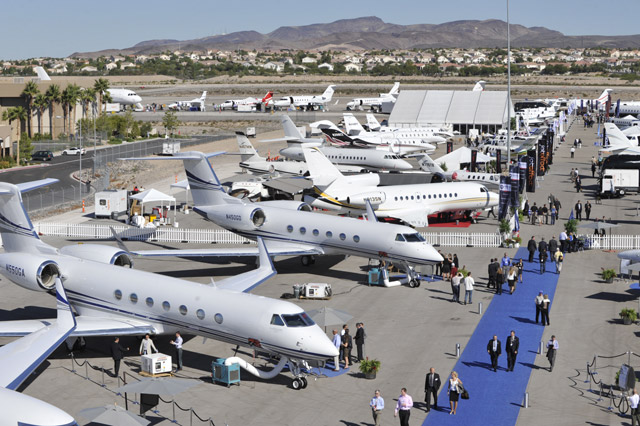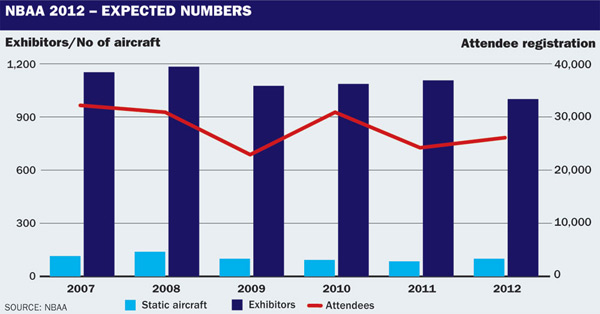The National Business Aviation Association will raise the curtain on its 65th annual convention and exhibition on 30 October at the Orange County Convention Centre, Florida.
Despite the endless conveyor belt of global aviation shows, conferences and exhibitions, this three-day event retains its title as the biggest and most important of all the business aviation industry fixtures.
 |
|---|
| NBAA Over 100 aircraft will be on display in two static parks |
Given its longevity and location in the world's largest business aircraft market, this is perhaps not surprising. The convention is a leading barometer and focal point for this global industry. "Business aviation operates in an international marketplace and many of the economic and political issues impact the industry as a whole," says NBAA president Ed Bolen.
ECONOMIC MISERY
Bolen admits the stubbornly persistent financial downturn and fragile economic climate continue to pose significant demands on the battered industry. "We have had around four years to adjust to these financial circumstances and the economic challenges refuse to go away," he says. "But this is a determined and resilient industry and it will continue to navigate through these testing times."
These demands have taken various forms: from depleted orderbooks and hefty job cuts to damaging portrayals of business aircraft as luxury toys for the rich and famous - mainly at the hands of the popular press and a clutch of politicians.
"Many of these challenges refuse to go away, " Bolen concedes. "Unfortunately, the misconceptions of what we stand for are so widespread. But we will continue to promote the true face of business aviation - what it does for companies, countries and people. The reality about business aviation is clear to see and the facts are overwhelming."
Earlier this month, the NBAA reacted furiously to "disparaging" comments made by President Barack Obama during a televised presidential debate with Mitt Romney. Obama - not for the first time - argued for a change to laws that allow businesses which own their own jets to depreciate their value over five years, compared with seven for charter operators. "Why wouldn't we eliminate tax breaks for corporate jets?" Obama remarked. "My attitude is, if you got a corporate jet, you can probably afford to pay full freight, not get a special break for it."
Bolen says: "The president's comments completely mischaracterised the businesses and groups that depend on an airplane, the majority of which are small- to mid-sized businesses, farms, flight schools, medical care providers and emergency responders that use the aircraft to connect communities and grow their businesses."
But flawed public perceptions and the protracted economic downturn have failed to dampen the spirits of this embattled industry and the conference will host more than 1,000 companies, with 100-plus aircraft on display in the two static aircraft parks. The first area - a 50,000ft² (470m²) space next to the convention centre - will house light aircraft, turboprops and helicopters. The main aircraft exhibit will be based a short drive away at Orlando Executive airport.
About 25,000 business aviation professionals are also expected to converge on NBAA during the three show days.
"Every facet of the industry attends the show," Bolen says. "From big and small companies to associations and regulators. Even though budgets are tight, exhibiting at this show is a price worth paying."
NBAA FLUCTUATIONS
That said, the NBAA convention has not been immune to the downturn. Exhibitor and visitor numbers have swung wildly since 2007 - a record year for the show - in line with fluctuations in the business aviation market.
"By every measure, business aviation went down precipitously with the downturn," Bolen says. "The industry is starting to turn a corner. We [at NBAA] are now making progress and working our way back towards those pre-recession numbers."
This view is echoed by John Rosanvallon, president of Dassault Falcon: "We have kept our presence at NBAA low-key for around four years. However, we are starting to see a resurgence - particularly in the USA - so this year we are going to exhibit on a much bigger scale."

Dassault will display its full aircraft line up, including its Falcon 2000S, which is making its show debut ahead of planned certification later this year.
Embraer's Legacy 450 will also make its first public appearance at NBAA. The mid-light business jet will take centre stage alongside its Phenom 100/300, Lineage 1000 and Legacy 650 stablemates.
Cessna - celebrating its 85th anniversary this year - will display a full range of aircraft including the new Citation M2 light business jet and the Citation TEN - both earmarked for certification in 2013 - and the Corvalis TTX high-performance piston single. The large-cabin Longitude - launched in May - will be on display in mock-up form at Cessna's booth.
Gulfstream's recently certificated G650 and super-midsize G280 will take centre stage at its exhibit alongside the G150, G450 and G550.
Bombardier will feature its Learjet 75 test aircraft - equipped with Garmin G5000 avionics - for the first time. A mock-up of the superlight business jet and its light jet stablemate will also be on display. The pair will replace the Learjet 40XR and 45XR when they enter service next year. Bombardier's Global 6000, Global 5000, Challenger 605, Challenger 300, 45XR and 60XR will also be on display.
Despite the company's uncertain future, it will be business as usual for Hawker Beechcraft at NBAA. "This is the most prominent business aviation show in the world," says president Bill Boisture. "We will have a full product line-up at our static display, while our convention centre booth will be dedicated to our global customer support business."
HOT DEBATES
Outside the exhibition halls and static parks, the conference rooms will host some lively debates. Hot on the agenda is the controversial European Union Emissions Trading System (EU ETS) which the NBAA describes as "particularly discriminatory against business aviation".
The association has fought alongside a number of other US aviation groups to block implementation of the EU ETS on US operators - which would require them to buy carbon credits to cover aviation carbon dioxide emissions.
The NBAA believes international standards governing aircraft emissions should be enacted via the International Civil Aviation Organisation, not unilaterally by the EU, says Bolen.
Its efforts finally paid off in late September, when the US Senate passed legislation preventing all US operators from participating in the EU ETS. The House of Representatives passed similar legislation earlier this year, and the two bills must now be reconciled into a single measure for a final vote from both legislatures, says Bolen.
The perennial threat of user fees will also come under the spotlight at the conference. The US government's plans to impose a $100 user fee for every business jet flight is dismissed by Bolen as "ill-conceived and counterproductive".
"GA currently pays through an efficient per-gallon fuel charge at the pump," he says. "This plan would create an onerous new administrative burden and necessitate the creation of a costly new fee-collection bureaucracy."
Meanwhile, international focus will fall on China, where entrenched bureaucracy and burdensome regulations governing aircraft operations continue to hamper business aviation's expansion. "China is a key market for business aviation, but there are a number of restrictions to address before it can fully open up," says Bolen.
Source: Flight International



















